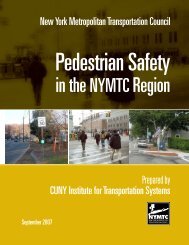Chapter 3 The Transportation System - New York Metropolitan ...
Chapter 3 The Transportation System - New York Metropolitan ...
Chapter 3 The Transportation System - New York Metropolitan ...
- No tags were found...
You also want an ePaper? Increase the reach of your titles
YUMPU automatically turns print PDFs into web optimized ePapers that Google loves.
<strong>Chapter</strong> 3Long Island Rail Road and MTA subway entrance at Penn Station, <strong>New</strong> <strong>York</strong> City1. INTRODUCTION<strong>The</strong> <strong>New</strong> <strong>York</strong> metropolitan area has oneof the oldest, most complex and highlyutilized transportation networks in theworld. On a typical weekday, the region’smultimodal transportation networkhandles millions of passenger trips andthousands of tons of freight shipments.Public transportation mode share ismuch higher than in other regions ofthe United States. Within the NYMTCplanning area, the transportation systemincludes:• Nearly 480 route miles of commuterrail and 225 route miles of subwaytracks in passenger service, plus hundredsof miles of local, express, commuter,and intercity bus routes andan aerial tramway;• An extensive network of passengerhubs, such as bus terminals andsubway transfer facilities, ferry landings,and train stations where peopletransfer between modes of transport,including one of the most successfulrail-to-airport links in the country;• More than 1,100 miles of bicycle facilities,ranging from shared-use biketrails to on-road bike lanes, in additionto pedestrian sidewalks, trails,and paths;• More than 50,000 lane miles ofroads and highways, includingmore than 30 major bridges crossingnavigable waterways (there areover 3,200 bridges of all types inthe region), four major underwatervehicular tunnels, and special lanesfor high occupancy vehicles (HOVs)and buses;• Four commercial service airports,plus general aviation and heliportfacilities;• Major deepwater seaport facilitiesowned and operated by a mix ofpublic and private sector entities,plus an extensive network of marinecargo support infrastructure and services;• An extensive network of inland waterwayssupporting barge and ferryservices;• More than 400 route miles of freightrail, some of which is shared withcommuter rail services;• A widespread network of freighthubs, including rail transfer facilities,rail yards, and truck-orientedwarehouse and distribution centers;and3-4 Plan 2040: NYMTC Regional <strong>Transportation</strong> Plan
















